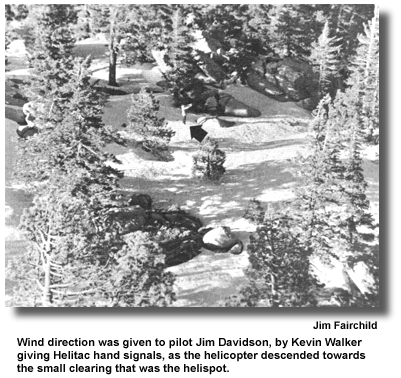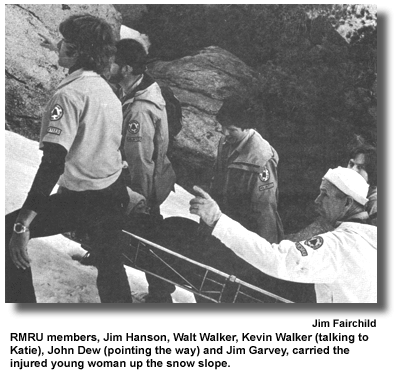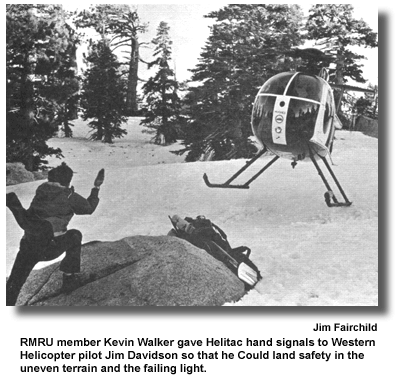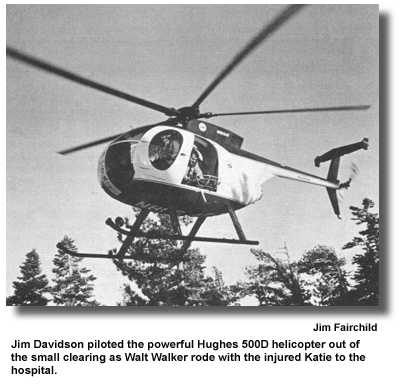Horse and owner injured
|
May 10, 1978 |
 |
By Kevin Walker
 At approximately 1:00 p.m. Wednesday
while I was preparing to start running a job on
my press, I heard the familiar sound of my
grandfather's voice, summoning either my dad or I
to the phone for a rescue mission.
At approximately 1:00 p.m. Wednesday
while I was preparing to start running a job on
my press, I heard the familiar sound of my
grandfather's voice, summoning either my dad or I
to the phone for a rescue mission.
After having several body evacuations from plane crashes, I was very pleased when I heard that we were to investigate an ELT (emergency location transmitter) signal emanating from the Red Tahquitz area in the San Jacinto Mountains.
We were met at the Banning Airport by Capt. Ray Canova of the Banning Sheriff's Office and a Major of the Civil Air Patrol and his T-6. It was decided that Walt and the Major should fly over the area and try and find the wreckage.
After about 30 minutes they returned to the airport, where to our amazement Walt informed us that he had spotted what looked like an orange tent and someone waving to him, but no wreckage was visible. But never the less, at least one survivor.
 With that, we immediately asked for
a helicopter. After 15 minutes the Capt. informed
us that Scott Air Force Base had been notified
and we would be getting a Marine chopper within
the hour. After an hour and a half we began to
wonder if they forgot us or something.
With that, we immediately asked for
a helicopter. After 15 minutes the Capt. informed
us that Scott Air Force Base had been notified
and we would be getting a Marine chopper within
the hour. After an hour and a half we began to
wonder if they forgot us or something.
After checking with Scott again we were informed that there were not any choppers available for rescue.
It was now 4:00 p.m. Darkness would soon be a factor in this mission, and to top it off storm clouds were approaching from the north-west. It was decided to call Western Helicopters, in Rialto. We then moved up to Idyllwild where we had a quick dinner and then set up base.
At 5:30 p.m. we were joined by one of Western's new Hughes 500D helicopters. First load in was Jim, Walt and myself. After sneaking under the now present clouds, we started searching. After a few passes in the area, Walt spotted tracks on the PCT and upon following them further we spotted not only one but two people waving, and another in a tent right in the middle of the trail.
The pilot found a small clearing large enough to land in on the ridge above the parties camp. After we were let off the pilot left for more men and equipment. Upon reaching the camp we were met by two men and a young woman in the tent. After questioning them about the ELT, the girl responded back that it was her ELT and she had activated it after she became injured, and was found by two other hikers.
While Walt
examined her for injuries we were told what led
up to the accident. Kathryn (Katie) Joost was
doing the San Jacinto segment of the PCT solo,
and on horseback. Tuesday afternoon Katie reached
an icy point on the trail. She dismounted and led
her horse across the icy spot, and just as she
was returning to get her pack animal, it started
towards her. As it was crossing the icy patch, it
slipped and fell. The animal fell about 100 ft.  Upon reaching the animal, Katie
found that the horse was severely injured and it
would be best to destroy it. Using a 25 caliber
pistol, Katie shot the animal. It then fell
another 200 ft. Thinking that the horse was now
dead, Katie started back up to the trail
gathering up her gear. Part of the way up she
slipped and fell herself. In the fall Katie
injured her right hip, lower back, received a
blow to the head, and also had many bruises on
her body. She managed to find her sleeping bag
before darkness came. Wednesday morning the two
hikers also doing the PCT came across the site
where the horse fell. They then followed the
debris down to where Katie's sleeping bag was.
Katie was feeling a little better so they were
going to move her back to the trail, when they
heard the horse whinnying down below. This time
using a 30-30 rifle they went down to shoot it
again. Katie said she would take care of the
horse. To top it all off, when she shot it, the
horse kicked her in the left shin. With this
injury, it made it impossible for her to walk.
After one of the men finally destroyed the
animal, they carried Katie back up to the trail
and set up her tent, and put her back into her
bag. It was at this point she had them activate
her ELT and at that point RMRU fit into the
complex picture.
Upon reaching the animal, Katie
found that the horse was severely injured and it
would be best to destroy it. Using a 25 caliber
pistol, Katie shot the animal. It then fell
another 200 ft. Thinking that the horse was now
dead, Katie started back up to the trail
gathering up her gear. Part of the way up she
slipped and fell herself. In the fall Katie
injured her right hip, lower back, received a
blow to the head, and also had many bruises on
her body. She managed to find her sleeping bag
before darkness came. Wednesday morning the two
hikers also doing the PCT came across the site
where the horse fell. They then followed the
debris down to where Katie's sleeping bag was.
Katie was feeling a little better so they were
going to move her back to the trail, when they
heard the horse whinnying down below. This time
using a 30-30 rifle they went down to shoot it
again. Katie said she would take care of the
horse. To top it all off, when she shot it, the
horse kicked her in the left shin. With this
injury, it made it impossible for her to walk.
After one of the men finally destroyed the
animal, they carried Katie back up to the trail
and set up her tent, and put her back into her
bag. It was at this point she had them activate
her ELT and at that point RMRU fit into the
complex picture.
After completing the exam, Walt decided we would need a litter, full leg air splint, and the rescue sleeping bag. Upon the birds return we were joined by fellow team members John Dew, Jim Garvey, and Jim Hanson.
With the
needed equipment now on the scene, we moved as
fast as possible because of the fast approaching
darkness. With Katie now in the rescue sleeping
bag, we loaded her into the litter and made our
way to the ridge. Upon the return of the chopper, we
loaded the litter into the bird. Walt rode out
with Katie to the Palm Springs Hospital.
Upon the return of the chopper, we
loaded the litter into the bird. Walt rode out
with Katie to the Palm Springs Hospital.
With the bird's return to the mountain, we quickly loaded gear and two men into the bird. The pilot asked me if there was anywhere close by where he could let us off. I told him Garner Valley was the closest accessible roads. He said fine, because it was now impossible to fly to Idyllwild because of cloud cover. With that it took only three runs to Garner Valley with the bird to get us all out. And at 8:00 p.m. with help from the with Hemet Search and Rescue Team in transporting us back to Hemet and Idyllwild, Mission No. 1978-022 was secured.